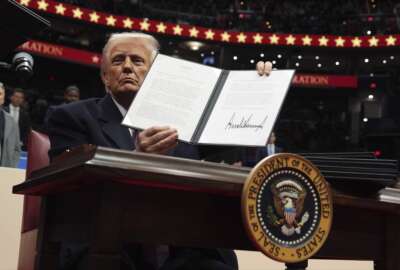Which lawmakers are fed-friendly on Capitol Hill?
Federally Employed Women released its annual Voting Record Scorecard. Now, federal employees can see which lawmakers are supporting legislation that helps them.
wfedstaff | April 17, 2015 6:06 pm
The House’s vote to pass the budget deal is the the first good news many federal employees have had in three years — the bill fully funds President Barack Obama’s 1 percent pay increase.
It’s also the first of many votes in this session of Congress that will impact voting records.
Janet Kopenhaver is the Washington representative for Federally Employed Women, which released it annual scorecard that shows which legislators are fighting for the federal workforce. 
“Co-sponsorships would be bills that our members have actually sent letters to legislators, asking them to co-sponsor,” Kopenhaver told In Depth with Francis Rose recently. “We take those 10 votes or co-sponsors and give them 10 points for each one where they voted or took action in concert with FEW’s views. We score them basically the way up to 100 percent.”
Based on these criteria, FEW had a record number of perfect scores in the House, with the number rising in 2013 from from 45 to 57. In the Senate, the number grew from 3 to 13 over 2013.
“Our champions certainly became more entrenched,” Kopenhaver said. “They knew federal workers were getting beat up and I think that’s why a lot of the scores went up, the number of 100s went up. The people who are champions for five, six, even seven consecutive years continue to go up.”
While FEW was pleased to see that growth, a closer look at the numbers reveals some troubling trends.
“The number of those who scored a zero, a big goose egg, went up exponentially,” Kopenhaver said. “In the Senate, it went from two in 2012 to eight this year. But in the House, we had zero people scoring zero in 2012 and it went to 81 for this first session of the 113th Congress. That has us very, very concerned, because that means the partisanship is just getting so much worse. Each side is just digging in their heels and the opportunity for compromise just keeps getting pushed further and further aside, because the parties are just voting with parties now.”
Here are FEW’s Federal Worker Champions, who scored 100 percent or 90 percent for four to seven consecutive years:
Seven Consecutive Years
- Rep. Stephen Cohen (D-Tenn) 100 percent this year
- Rep. Elijah Cummings (D-Md.) – 100 percent this year
- Rep. John Sarbanes (D-Md.) – 90 percent this year
Six Consecutive Years
- William Lacy Clay (D-Mo.) – 100 percent this year
- Rep. Jim McGovern (D-Mass.) – 100 percent this year
Five Consecutive Years
- Rep. Gerry Connolly (D-Va.) – 100 percent this year
- Rep. Janice Schakowsky (D-Ill.) – 100 percent this year
- Sen. Barbara Boxer (D-Calif.) – 90 percent this year
- Sen Robert Mendendez (D-N.J.) – 90 percent this year
Four Consecutive Years
- Rep. Hank Johnson (D-Ga.) – 100 percent this year
- Rep. Chris Van Hollen (D-Md.) – 100 percent this year
“It’s been a rough year for federal workers, so to see all these reports is great. It’s just on the flip side to have so many zero reports is troublesome,” Kopenhaver said.
Looking ahead to the 2014 scorecard, Kopenhaver said FEW will need to look at the omnibus currently making its way through Congress to see what amendments are added that will affect federal employees.
“Certainly, we have the budget resolutions taken care of, so we won’t have that to vote on,” she said. “But, as we’ve mentioned in the past, the devil’s in the details. We still have to look at what these final funding bills. They still have to go through the appropriation committees and process.”
While grassroots efforts have been important in the past, Kopenhaver is concerned that those types of efforts, where constituents tell their representatives in Congress how they want them to vote, may not be as effective in times when partisan politics seem to be running things.
“With this partisanship and the break between the two [parties] so large now, I’m sort of wondering, OK, are they listening to these constituents?” she said. “They should be because these are the people who put them in office. Or are they listening to the leadership and who’s telling them how to vote. That’s both parties. That’s not one party or the other.”
Despite these concerns, FEW still encourages its members to send letters.
“We have heard that legislators and leaders in the Congress have said, ‘If we don’t hear from constituents, from federal workers, then we assume that they agree with what we’re doing,’ and that’s not true either,” Kopenhaver said. “We still encourage FEW members to send letters in and certainly to look at the scorecard, look at how their legislators voted and their co-sponsor status and send them a letter to let them know they’re watching.”
RELATED STORIES:
How the spending bill affects the federal workforce
Senate approaches final OK of $1.1T spending bill
Copyright © 2025 Federal News Network. All rights reserved. This website is not intended for users located within the European Economic Area.
Michael O’Connell is senior digital editor of Federal News Network optimizing content for the best user experience. Follow @moconnellWFED
Follow @moconnellWFED






